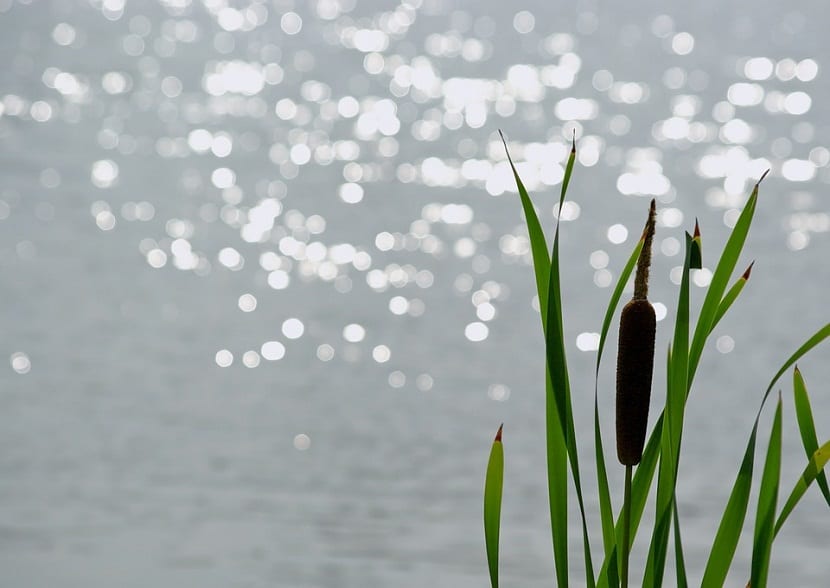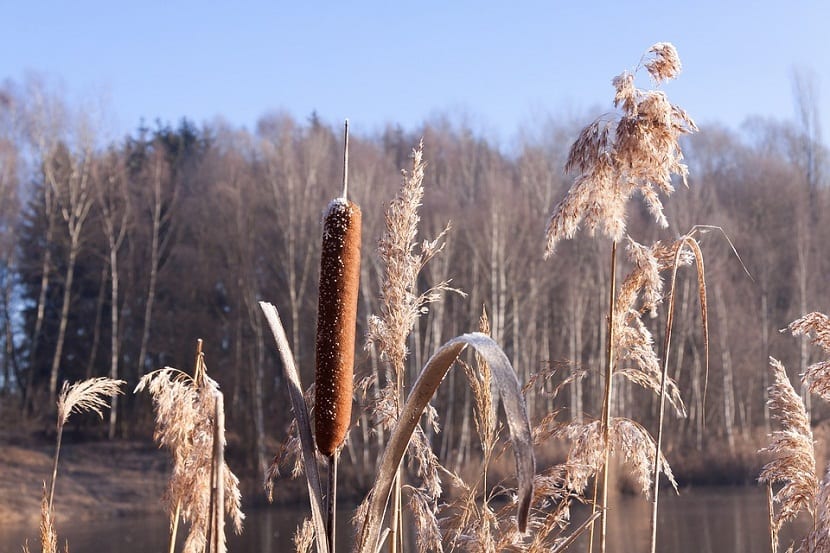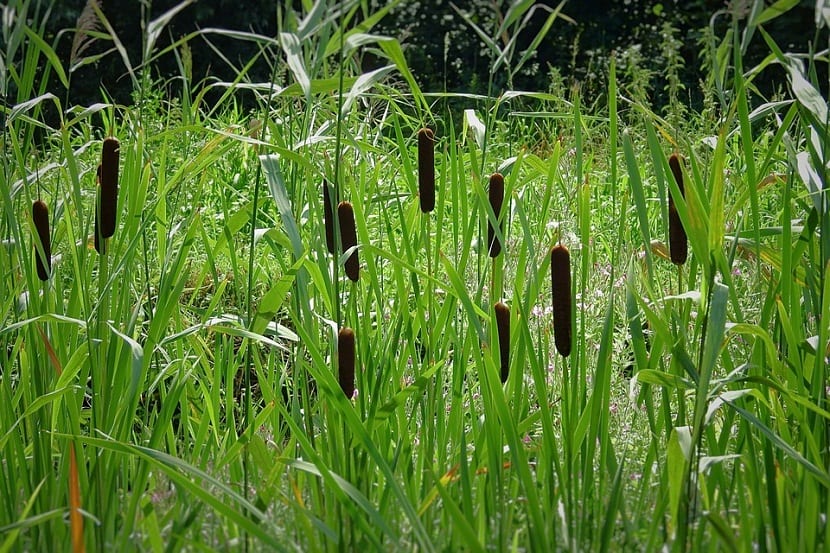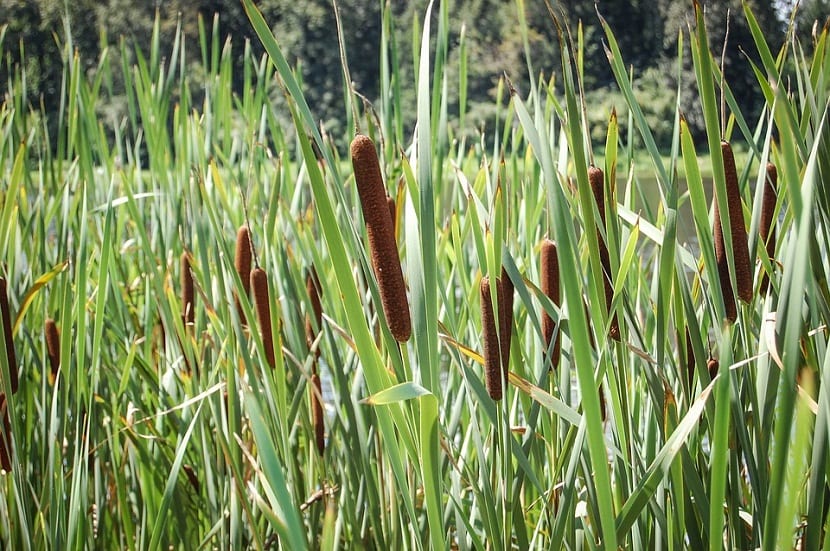
There is a plant located on the banks of rivers and lakes that has become a familiar image, being a tall spike with a characteristic cylindrical formation that is often drawn in the mind when imagining marshy landscapes.
This plant is the Typha, also known by the names of Cattail, cattail, cattail gladio or cattail.
Features

Its leaves have been used for centuries to make baskets, chairs and other items. It has been very useful as a tissue material.
The rhizome is consumed in many parts such as Bolivia and Peru, since it contains a high degree of starch, the tender shoots can be consumed cooked and pollen is used as a dietary supplement.
La Typha o Cattail was often considered a weed that grows indiscriminately at the edge of water sources, such as lakes and rivers. However, this ancient plant is noble, versatile and very useful both for human beings and for other living beings.
The genus of this plant has different species throughout the world. They are found in swampy and humid areas as quiet areas of fresh water, lakes, ponds, swamps, ditches and canals.
This aquatic plant with herbaceous characteristics, that is, hardy perennial grassIt can reach one to three meters in height with an average of 2,5 meters, with a rhizomatous stem.
The flowers are monoecious, that is, male and female flowers on the same plant. They have a characteristic terminal inflorescence and consist of a cylindrical spike of very dense flowers, the male above and the female below.
Leaves equal or exceed the height of the spikes. They are erect, bifacial, almost always basal, distal, sheathing, simple, undivided, flat, elongated and thin, with parallel venation, with spongy parenchyma.
The flowers are very small, unisexual, actinomorphic, and the female ones are hypogynous. The male flowers in spikes reach a height of up to 40 cm long and 15 mm wide and are separated from the female ones by 0,6-5 cm.
These flowers release pollen in tetrads or monads and the seeds have starchy endosperm. The fruit of the plant is dehiscent and achene type, with an acrid gynophore and acrid style.
Categories Typha
La Typha It is a plant that is widespread in various areas of the world, that is why it has different names, several species and different uses. What's more provide an excellent ecosystem for birds and insects, serving as raw material for bird nests and food for many species.
Typha latifolia
Also known as cattail, cattail, cattail bayon, reed of mats or passion and water mace, among others. This species grows in tropical and subtropical temperate zones from the northern hemisphere, blooming in summer and occurring in swampy areas. It can reach a height of one and a half to three meters and the leaves measure two to four centimeters wide.

Typha angustifolia
This other species is known by the common name of cattail, cattail and cattail. It is native to the northern hemisphere, especially North America, it is even found in Peru and Chile.
The stem of this plant is edible and it is very popular in Vietnam where they call it bón bón.
Typha domingensis
This and like the other species it is a herbaceous perennial plant, found in the Northern Hemisphere and especially in swampy areas. It was introduced in North America and is considered subcosmopolitan.
Care and cultivation
When you have or want to have a culture of Anea it is important to know some of its characteristics and follow some tips. Although it is a fairly resistant plant due to its wild nature, it is important to know the habitat where they easily thrive.
The location of the Typha should be done outdoors where it receives a good amount of direct sunlight. They should be planted in spring and once the risks of frost do not exist. Although it is not very demanding when it comes to the ground, it is very important that it has good drainage.
Being an aquatic plant, the degrees of humidity must be taken into account. The riverbank plant needs to have a wet stemHowever, the water cannot reach the leaves or at least not too much. Composting should be done in the warm months with minerals.
Pruning should be done when the inflorescences and leaves dry, preferably with scissors. It is a very resistant plant to pests and diseases And it can withstand the cold down to at least 4 degrees Celsius.
La Typha It is a plant that grows spontaneously, it is considered a weed and in some parts of the world as in Argentina they have even applied chemical treatments to eliminate them.
As it is a plant that is considered wild, there is no specific manual for its cultivation, however and thanks to the fact that it has lost a lot of land due to deforestation, some communities have resorted to planting them with the knowledge that was used in the past.
Uses of cattail today

La Typha, Anea or Totora has always had a traditional use and is that with its spikes baskets, furniture are made and in the case of some indigenous communities even small boats.
The tender shoots of the Typha angustifolia They are eaten as vegetables and are high in iodine. Some have also been determined medicinal uses to control fever and diarrhea.
Currently the most surprising function of this plant is its resistance to anoxic agents, being used in the field of phytoremediation with the aim of treating wastewater. Its use as a heavy metal phytoaccumulator.
Finally, it should be noted that it has served as a raw material to make paper for many years and its characteristic appearance and highly related to the humid landscape makes it an essential element in ornamental landscaping.
The different species of Typha have always been present in wildlife, and recognizing their value is becoming a Truly interesting ecological knowledge.